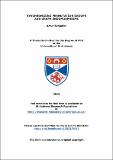Files in this item
Synchronizing permutation groups and graph endomorphisms
Item metadata
| dc.contributor.advisor | Ruškuc, Nik | |
| dc.contributor.advisor | Cameron, Peter J. (Peter Jephson) | |
| dc.contributor.author | Schaefer, Artur | |
| dc.coverage.spatial | 248 p. | en_US |
| dc.date.accessioned | 2016-12-01T12:52:24Z | |
| dc.date.available | 2016-12-01T12:52:24Z | |
| dc.date.issued | 2016 | |
| dc.identifier.uri | https://hdl.handle.net/10023/9912 | |
| dc.description.abstract | The current thesis is focused on synchronizing permutation groups and on graph endo- morphisms. Applying the implicit classification of rank 3 groups, we provide a bound on synchronizing ranks of rank 3 groups, at first. Then, we determine the singular graph endomorphisms of the Hamming graph and related graphs, count Latin hypercuboids of class r, establish their relation to mixed MDS codes, investigate G-decompositions of (non)-synchronizing semigroups, and analyse the kernel graph construction used in the theorem of Cameron and Kazanidis which identifies non-synchronizing transformations with graph endomorphisms [20]. The contribution lies in the following points: 1. A bound on synchronizing ranks of groups of permutation rank 3 is given, and a complete list of small non-synchronizing groups of permutation rank 3 is provided (see Chapter 3). 2. The singular endomorphisms of the Hamming graph and some related graphs are characterised (see Chapter 5). 3. A theorem on the extension of partial Latin hypercuboids is given, Latin hyper- cuboids for small values are counted, and their correspondence to mixed MDS codes is unveiled (see Chapter 6). 4. The research on normalizing groups from [3] is extended to semigroups of the form <G, T>, and decomposition properties of non-synchronizing semigroups are described which are then applied to semigroups induced by combinatorial tiling problems (see Chapter 7). 5. At last, it is shown that all rank 3 graphs admitting singular endomorphisms are hulls and it is conjectured that a hull on n vertices has minimal generating set of at most n generators (see Chapter 8). | en_US |
| dc.language.iso | en | en_US |
| dc.publisher | University of St Andrews | |
| dc.subject.lcc | QA175.S3 | |
| dc.subject.lcsh | Permutation groups | en |
| dc.subject.lcsh | Endomorphisms (Group theory) | en |
| dc.title | Synchronizing permutation groups and graph endomorphisms | en_US |
| dc.type | Thesis | en_US |
| dc.contributor.sponsor | Engineering and Physical Sciences Research Council (EPSRC) | en_US |
| dc.contributor.sponsor | University of St Andrews. School of Mathematics and Statistics | en_US |
| dc.type.qualificationlevel | Doctoral | en_US |
| dc.type.qualificationname | PhD Doctor of Philosophy | en_US |
| dc.publisher.institution | The University of St Andrews | en_US |
This item appears in the following Collection(s)
Items in the St Andrews Research Repository are protected by copyright, with all rights reserved, unless otherwise indicated.

